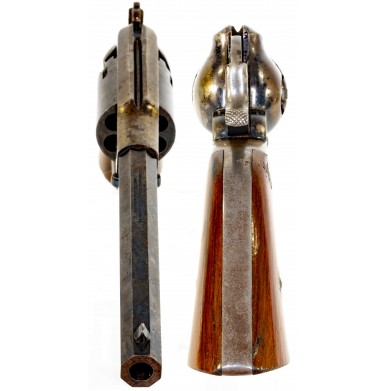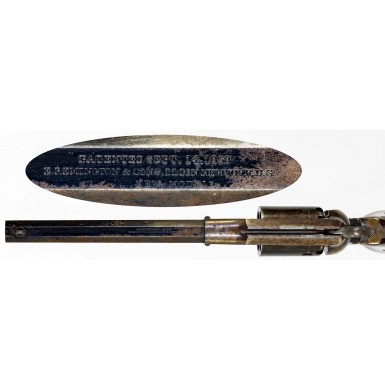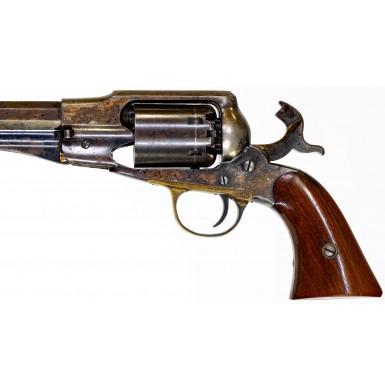Fine Remington New Model Navy Percussion Revolver
- Product Code: FHG-B226-SOLD
- Availability: Out Of Stock
-
$3,750.00
In 1857, the firm of E. Remington & Sons of introduced their first percussion revolver. Since the founding of the firm in 1816 by Eliphalet Remington, the company had concentrated on the production of gun parts, primarily rifle barrels, and then long arms. In 1856, with the addition of Remington’s three sons to the business, the firm officially became E. Remington & Sons. The following year, their first revolver was ready for sale, the Remington-Beals Pocket revolver. This was the invention of Remington employee Fordyce Beals. Beals had been instrumental in the production of the Jenks carbine contract, and had actually been acquired from Ames, as had the machinery, as part of the negotiated arrangement between Remington and Ames. Beals’ design was a compact, single action, .31 caliber revolver that bore a resemblance to the “Walking Beam” revolver then in production by Whitney. This should come as no surprise as the Whitney revolver was based upon Beals’ 1854 patent which evaded Colt’s protection of his pistol’s mechanism. In 1856, Beals patented the features that were salient to his new Remington revolver, and in 1858 patented the cylinder pin and loading lever system that would define the silhouette of all the large-frame Remington handguns for some three decades, through the Model 1875 which would remain in the product line through 1889.
Beals’ 1858 patent (#21,478) was granted on September 14th of that year and covered the winged cylinder arbor pin that secured the cylinder to the frame, which was retained by the loading lever located under the barrel and could be withdrawn from the frame only when the lever was lowered. Thus, began the evolution of the second most used US marital revolver of the American Civil War. The first guns were produced in .36 caliber and production started to roll off the assembly line during late 1860 or early 1861. The .36 caliber “Navy” revolver was followed by a .44 caliber “Army” variant soon thereafter. By the time Beals-Navy production ended in 1862, some 15,000 of the handguns had been produced, while only about 2,000 of the larger “Army” revolvers were manufactured, before the William Elliott “improved” Model 1861 pattern Remington revolvers (also known to collectors as the “Old Model”) superseded the Beals model.
The Beals Navy Revolver was Remington’s first large frame, martial handgun to make it into production. The earlier Beals “Army”, a scaled-up version of the pocket model, was only produced as a prototype and it is believed that less than 10 were manufactured. The Beals Navy was a single action, 6-shot revolver with a nominally 7 ½” octagonal barrel that was screwed into the solid frame. While most references list the barrel length as 7 ½” some of the earlier examples measure closer to 7 3/8” in length. The guns were blued throughout, with brass triggerguards and a color casehardened hammer. The gun had two-piece smooth walnut grips, secured by a screw that passed through German silver escutcheons and a cone shaped German silver front sight was dovetailed into the top of the barrel near the muzzle. There were a number of differences between the Beals model and the later production “Old Model” 1861 and the final “New Model” 1863 revolvers. The most obvious visual differences were the “high spur” hammer and the fact that frame concealed the barrel threads at the rear of the barrel. Shortly after the “Old Model” 1861 went into production, these features were eliminated. A relief cut in the frame revealing the threads at the barrel’s end was added to reduce the possibility of cylinder lock up due to fouling and a lower spur hammer was adopted eventually to reduce the potential for breakage. The system of retaining the cylinder arbor pin via the loading lever evolved as well. While the Beals revolver required the lever to be lowered to withdraw the pin, the Model 1861 included a relief cut in the top of the lever that allowed the pin to be pulled forward with the lever in its upright and locked position. This was considered an improvement and the feature was patented by Remington employee William Elliot, who would be responsible for a number of successful Remington firearms designs. This “improvement” proved to be a failure in the field, as the arbor pin could slide forward in the relief cut under recoil. When this happened, the cylinder often locked up, making the revolver useless. An eventual “fix” was developed for this potentially fatal flaw. A filister head screw was added to the inside of the loading lever that acted as a stop against the cylinder pin. This meant that the lever again had to be lowered to remove the pin, essentially returning the design to the original Beals concept and nullifying Elliot’s improvement.
The Beals models did not have safety notches on the rear of the cylinder that would allow the hammer to be safely dropped and locked between cylinder chambers. This feature was added to the Model 1861 and 1863 revolvers. Other minor evolutions occurred as well, including making the loading lever slightly larger and more robust. As the Beals was the first of the large frame martial Remington revolvers it underwent some changes and improvements during its production.
The US government had been relatively pleased with the original Beals Navy design and had obtained some 11,249 of the 15,000 Beals Navy revolvers produced. The purchases had been a combination of direct contract with Remington combined with open market purchases of some 7,250 revolvers that would not pass through a government inspection process. In June of 1862, the Ordnance Department let a contract for 5,000 additional “Navy” caliber revolvers to Remington. The guns delivered under this contract appear to be a combination of late Remington Beals Navy revolvers and the new Model 1861 Elliott revolvers. The serial numbering of the Model 1861 revolvers continued from the Beals Navy revolvers, with the numbers mixing somewhat randomly at the end of Beals production and the beginning of Model 1861 production. This can probably be attributed to the using up of older parts on hand, thus the existence of “transitional” Remington Navy revolvers. Between August and December of 1862, a total of 5,001 .36 Remington Revolvers were delivered under this contract. Due to reports of issues in the field with the new Elliott Model 1861 revolvers, modifications and improvements occurred during the production of the “Old Model” Navy revolvers, which eventually morphed into the “New Model” or Model 1863 revolvers. Interestingly after finally getting the Remington Navy design to its pinnacle, no additional .36 caliber revolvers would be purchased from Remington by the Ordnance Department after the final December 1862 deliveries. Instead, the US military decided to concentrate on the acquisition of .44 caliber percussion revolvers and a large number of the New Model 1863 Army revolvers would be acquired between 1863 and 1865. In fact, roughly 80,000 of the New Model Army revolvers were purchased during the last two years of the war, while Remington would only produce about 22,000 New Model Navy percussion revolvers from the time of their introduction until the summer of 1871 when percussion production of that model came to a halt. In all some 148,000 “Army” sized Remington revolvers of all variants were produced with only about 48,000 of the “Navy” sized guns produced during the same period.
Offered here is a FINE condition example of a Remington “New Model” 1863 Navy Revolver. As noted, none of the roughly 22,000 New Model Navy revolvers were acquired by the US Government, so these were all civilian guns or guns acquired on the open market in small numbers by some of the states and other military organizations who took the arming of their men into their own hands. Since there was a limited market for these (and other) percussion revolvers without a government contract, particularly after the end of the war, Remington started looking at ways to make the New Model Navy more saleable. Starting in the summer of 1871 the firm started to offer these guns as cartridge conversions in .38 caliber, primarily in rimfire but also in centerfire. These factory alterations started to appear around serial number 36,000 and around serial number 42,000 the guns were simply being produced as cartridge revolvers and were not altered percussion guns. This revolver is number 35973 and was likely produced sometime in late 1864 or in 1865 and apparently sold before the beginning of the factory alteration program. The serial number is present on the frame under the left grip, under the barrel (concealed by the loading lever) and the partial serial number written in period pencil inside both of the grips. The cylinder of this revolver is not serial numbered. Serial numbers are not regularly encountered on the rear of later production Remington revolver cylinders, but on the earliest guns they are fairly common. However, there is a Winspection mark on the rear face of the cylinder. This transitional gun appears to be in a range when the cylinders were becoming more likely to be unnumbered.
The 7 5/16” octagonal barrel of the revolver is roll marked in three lines on the top flat:
PATENTED SEPT. 14, 1858
E. REMINGTON & SONS ILION, NEW YORK U.S.A.
NEW MODEL
As noted, the revolver remains in FINE condition and retains some nice original finish. The revolver is extremely crisp throughout with sharp edges and clear markings. The gun retains about 30%+ of its original blued finish overall, with the loading lever retaining the most finish and the other primary components showing similar amounts of blue. The loss appears to be primarily from flaking, rather than wear or poor storage. The flaking has left the gun with a mottled appearance over most of its surfaces with the bright blue mixed with a lightly oxidized brownish gray patina. The metal is almost entirely smooth with only some very lightly scattered minute flecks of surface oxidation here and there. The hammer retains some of its original color casehardening and has a pleasing mottled bluish appearance, even if the colors have dulled and muted some. The brass triggerguard has a mellow, dark golden patina that is quite attractive.
The bore of the revolver is in FINE condition as well. It is mostly bright and retains extremely crisp rifling throughout. The bore shows some very lightly scattered areas of surface oxidation, some scattered pinpricking, and some frosting in the grooves. The revolver remains in mechanically excellent condition and functions correctly in every way. The revolver times, indexes and locks up exactly as it should. The loading lever functions smoothly and locks into place securely. The cones (nipples) all appear to be original and although they show some light wear but remain fairly crisp and fully functional. The original pinched blued steel blade front sight is in place on the top of the barrel near the muzzle and remains fully height and is not worn down or damaged. The two-piece smooth, varnished walnut grips remain in VERY FINE condition and are really extremely nice. They are solid and are free of any breaks, cracks, or repairs. The grips are very crisp but do show some scattered bumps, dings, mars, and handling marks. As noted, both grips are pencil numbered to the gun on interiors.
Overall, this is a really very nice and very crisp example of a fairly scarce Remington “New Model” 1863 Navy Revolver. The gun retains much of its original finish and is extremely crisp throughout. Only about 10,000 of these revolvers were produced before Remington stated doing factory cartridge alterations on them and the last 6,000 or so were produced as cartridge guns, not as percussion ones. That makes a high condition percussion New Model Navy a relatively hard gun to find on the market. This is a great example to add to your collection of Remington percussion revolvers or as part of a “Secondary Martial” collection of Civil War percussion revolvers. I know some people that have searched for some time to find one of these guns for their collection and this is a nice enough example to satisfy almost any collector.
Tags: Fine, Remington, New, Model, Navy, Percussion, Revolver










